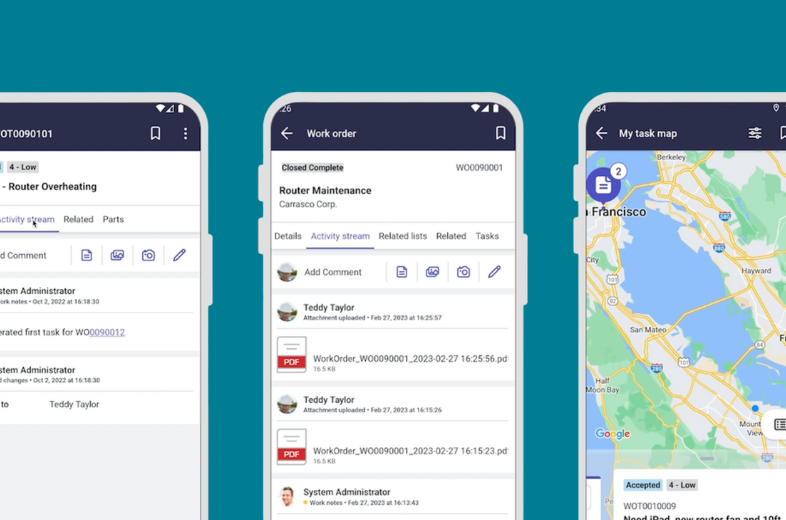Data is Your Strategic Field Service Asset

Published Date
What’s the most important and strategic asset of your organization?
It’s not the buildings or the machines and software that run your operations. And while your people are critical thanks to their agility and years of learned knowledge, it’s not them either.
It’s your data – The data your machines in the field can produce every moment of operation.
Diving into Data
Most of us use Amazon, Netflix, and Google. These companies are successful because they consistently deliver value to their customers which encourages us to come back for more.
How do these companies do it? They use data as a strategic asset.
They track searches, clicks, views, and more to cater to users’ individual preferences so they can serve them with other relevant content they’ll likely show interest in. The same data is versatile and is also used to forecast future offerings and programming on a global scale.
By viewing data as a strategic asset, these companies create competitive advantages in their respective markets.
These examples point to a larger question in our industry – why don’t field service companies use their data this way?
Why do companies wait for their customer to call and tell them their machine is down? Catastrophic failures can result in higher repair costs and extended downtime.
So, why don’t we use data from customers’ machines to tailor service offerings to meet their specific needs?
Jaded by the Hype
According to the IIC “Five to seven years ago, analysts were predicting massive growth in the Industrial Internet of Things market. As soon as one analyst firm published a report predicting 30 billion devices connected by 2025; another would predict 40 billion devices by 2030. Expectations were high. Riding the hype was essential. The market was viral.”
At that time, the Internet of Things (IoT) had become associated with artificial intelligence (AI), machine learning (ML), and physics-based digital twins to name a few.
Many IoT startups gave the solution to collect data and store it, but then what?
Other companies tried to introduce their industry optics, but the barriers to value were too high. This resulted in hundreds of IoT projects getting bogged down in “pilot purgatory.”
At this point, the fresh face of IoT became just another over-hyped technology for solving our problems.
Seeing Clearly
By 2021, a paper by McKinsey showed hope for a path out of the haze of disillusionment.
Companies still perceived value from IoT even if they hadn’t achieved the “how.” But most importantly, the equipment manufacturers recognized that data was critical and so sensors on assets became standard.
Connectivity, security, and value remained a challenge. However, capturing data became less of a hindrance.
A First-Hand Account: Viewing Data-Driven Transformation as a Journey
Long before I became the Vice President of Software Sales at Bolt Data, I was involved with IoT. And, in 2016, when I was with ServiceMax, I owned a strategic relationship with PTC. At the time, PTC didn’t see a future in the service operationalization of IoT data and gave their entire field service book of business to ServiceMax. Their focus was on IoT to enable product design and quality improvement to bolster their CAD/CAM solutions and strengthen Product Lifecycle Management (PLM).
After ServiceMax, I moved on to GE Digital where it was all about building physics models that would allow a machine to simulate a physical machine's behavior, compare to actual machine sensor readings, and be able to predict impending asset failures or identify remedial actions/tuning by spotting anomalies.
This is an exceptionally fine and lofty goal that’s still firmly locked away with researchers.
If you’re interested in reading the current research on the topic, Google, “Journey to physics model digital twin.”
There are Real Opportunities on this Journey Now
I enjoy sailing, and a common phrase you hear in the community is “Powerboats are about the destination, sailing boats are about the journey!”
We’re all on a journey with IoT, and now, we can enjoy it and deliver value along the way.
Below is a hypothetical data asset journey:

Using this journey, I can broadly categorize prospects I speak to into four categories:
- We’re not collecting asset data. If that’s what boat you’re in, this blog’s for you. By not collecting asset data, you’re missing opportunities and setting yourself up to potentially waste millions of dollars.
- We have IoT data, but we’re struggling to find achievable value. You recognize the opportunity you’re missing but are stuck on use cases that can deliver value.
- We’re trying to build a physics model. I appreciate the vision, and I’m sure you recognize the challenges of sufficient training data, particularly in the identification of learning opportunities. You’re no doubt frustrated by numerous false negatives and even more false positives. From my experience I can say you’ll reach your goal sooner if you go on the asset data journey.
- You’re on the asset data journey and see a use case in front of you that brings value and measurable results. I appreciate you and want to have a conversation with you, even if we don’t end up doing business together.
The Data as a Product (DaaP) Mindset
A strategic approach to asset data is like developing the foundation and scaffolding for your organization. This strong base is used to deliver change and shift the mindset from project to product focused.
This strategic way of thinking is the DaaP Mindset.
For world-class operations, data is not just a means to an end. It’s viewed as a strategic asset with enormous value to the organization and it’s managed accordingly.
Accenture summarizes the DaaP Mindset as “Data products productize data to accelerate value, improve decision-making, and even create entirely new revenue streams… Data products typically offer far greater ROI and lower cost-per-use than data projects, because they evolve to support multiple outcomes over time.”
Applying DaaP to your Assets
When the assets you manage are operating normally, they’re producing revenue and keeping your business viable.
As their performance degrades so does their productivity, and when they fail, they no longer contribute revenue to your business.
This idea comes full circle to the start of this blog post – your most strategic asset is your data.
DaaP is a product you can use to deliver value through your service operations whether delivered remotely or in the field.
With this context in mind, let’s revisit the asset data journey we previously discussed:
- Sensorize Assets: This is the prerequisite for the journey. You need meaningful data from the asset either from existing sensors or after-market.
- Single Use Case: This proves you can positively impact your business outcomes by using the data. Some examples are below, but you know where your pain points are and can identify alternatives to your business-as-usual status quo.
- Proactively schedule service and contact the customer when the asset alerts its offline
- Automate the creation and closing of service tickets to reduce operational costs
- Support service call justification with before and after asset repair data
- Dispatch the right technician with the right parts by leveraging pre-diagnosis of the issue for improved First Time Fix (FTF) and reduced Mean Time to Repair (MTTR)
- Provide service based on actual machine usage
- Predict when consumables need to be replenished
- Scale Use Cases: If you can prove value on one asset, you can scale it to all assets and scale your commercial and service impact.
- Identify New Anomalies: Leverage the expertise of your engineers. As they identify and resolve issues they can annotate the sensor data to mark insights about the failure, attach how-to articles, and build the knowledge base.
- Machine Learning: Based on your engineers' insights, you can start to reduce your false positives and predict more failures. You’ll also filter noise and be able to use human-driven analytics to identify other anomalies and improve threshold-based alerting. Your quality of service will continue to improve, as will your service metrics. Your customers will be happier which improves your Net Promoter Score (NPS).
- Asset Simulation: One day, technology will catch up with the vision and rather than research papers, we’ll read sweeping case studies. In the meantime, the business will have grown in efficiency, create positive top- and bottom-lines, and improve NPS. Additionally, much more data will have been created as well as learning scenarios to feed into the simulation.
The Time is Now
I have seen the rise of Field Service Management software, and am proud to have been part of ServiceMax. The ROI for companies that went on that journey with us, or our competitors, achieved tremendous returns on their investment.
The next step in the shift in service is to become data-driven. Bolt Data Connect is easy-to-implement and configures the solution to connect your asset data to their service and maintenance. You can read more in our datasheet, and I would love to have the opportunity to talk to you and hear your thoughts on this blog post.




